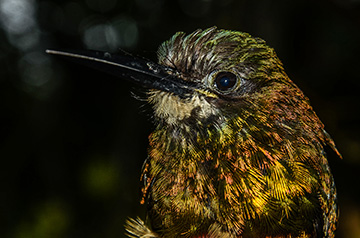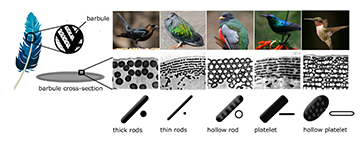
A white-chinned jacamar (Galbula tombacea), one of the iridescent species included in a new study of the structural roots of bird-feather iridescence across 15 avian orders. [Image: David Ocampo, Princeton University]
Birds have exhibited sometimes brilliant iridescent plumage for millions of years—but only recently have scientists had the technology and optical theory to tease out the nanophotonic structures that give feathers their resplendent colors.
A new survey of diverse avian species now offers an unusually broad view of the nanostructures behind the bright hues of iridescent feathers (eLife, doi:10.7554/eLife.71179). The study—by researchers at two US institutions, Princeton University and the Field Museum of Natural History—aims to provide an evolutionary framework for the building blocks of iridescence-producing feather structures across many species.
Types of melanosomes
Princeton biologists Klara Katarina Nordén and Mary Caswell Stoddard, together with a postdoctoral fellow from Field’s bioinformatics center, Chad M. Eliason, analyzed the types of melanosomes, the melanin-producing organelles that are the building blocks of barbules—structures that create the optical effects in feathers.
Melanosomes, the team notes, come in five basic types, four of which arrange themselves in photonic-crystal structures. Single-layered structures of thick solid-rod-type melanosomes, the non-photonic-crystal variety, produce colors that the authors called “weak” iridescence, with low brightness and color saturation.
Photonic crystals for “brilliant” colors
The other four types, all parts of photonic crystals, produce what the researchers term “brilliant” iridescence, with high saturation and brightness. For example, multiple layers of thin solid rods—acting as a one-dimensional photonic crystal—occur in the feathers of one pigeon species, Caloenas nicobarica. Hexagonally packed hollow rods result in an iridescent green color. The barbules of sunbirds contain solid-platelet-shaped melanosomes, whereas many hummingbird species have barbules consisting of hollow-platelet shapes.
Heinz Durrer—now a professor emeritus at the University of Basel, Switzerland—originally classified these five types of melanosomes in his 1977 doctoral thesis. Since then, many scientists have studied small groups of bird species, such as the cassowary. But the broad evolutionary principles underlying the many types of structural color have remained unknown.
Looking for key modifications
The researchers behind the new study, examining pigment-filled sacks, or melanosomes, within the nanostructures in iridescent feathers, looked at how the five primary types of melanosomes affect color brilliance. Thick rods are found in birds with weak iridescent coloring such as in the brown-headed cowbird (top row, left), while all other types produce brilliant iridescence, with the iridescence and its range largely tied to the thickness of distinct melanin layers in the structures. Microscope images adapted from H. Durrer, Schillerfarben Der Vogelfeder Als Evolutionsproblem, University of Basel (1977). [Image: Klara Nordén, Princeton University] [Enlarge image]
Nordén, Eliason and Stoddard, looking at evidence for feather nanostructures across 15 different bird orders, identified three characteristics of melanosomes that produce brilliant iridescence: thin layers of melanin (compared with the thick rods that produce weaker colors), an air-filled interior, and the overall shape of melanosomes (platelet versus rod). The team analyzed these shapes mathematically to tease out the optics of these nanostructures. Additionally, the Princeton and Field researchers compiled a database of feather iridescence for more than 300 bird species that have already been studied.
One common trait in all the brilliantly iridescent feathers: their melanin layers were less than 190 nm thick. The scientists learned that all four types of brilliantly iridescent melanosomes have similar optical properties, so that the differences among them is apparently rooted in the evolutionary history of the various species. However, the differing amounts of melanin in these tiny features has still not been studied. Another question remaining open is which evolutionary change came first: the shape of the melanocytes themselves or the organization of melanocytes into photonic crystals.
The authors acknowledge that the work—which seeks to uncover “general design principles” used by evolution in creating structural color in bird feathers—marks “only a first step toward gaining a deeper understanding of how brilliant iridescence has evolved in birds.” Still, they argue that their general study should provide “a powerful springboard” for those seeking to dive deeper into questions of how some birds evolved to sport their spectacular colors.

